Why to Consider Midjourney Alternatives
- No Storyboard Support: Midjourney doesn’t allow you to generate storyboards directly from scripts, making it hard to use in pre-production workflows.
- Lack of Contextual Continuity: Each image is generated independently, with no visual consistency across frames.
- No Video Output: Midjourney produces static images only — no support for motion, sound, or shot planning.
- Manual Prompting Overhead: Users must manually design each frame, which is time-consuming and inefficient for larger projects.
- Not Built for Filmmakers: Midjourney is a general-purpose image tool, not designed with filmmakers’ needs in mind.
- No Script Input Feature: You can’t upload a script and get visual results directly; it requires prompt engineering.
- No Audio/Voiceover Tools: Midjourney lacks tools for integrating voice, sound, or background music into generated outputs.
- Limited Collaboration: No built-in collaboration features for creative teams or agencies.
- No Duration/Shot Planning Controls: You can’t define shot length, angle, or transitions.
Quick Recap of Alternatives to Midjourney
Shai – AI storyboard generator for filmmakers, turning scripts into full storyboards and videos with sound, style control, and duration settings.
Story-Boards.ai – Lightweight AI tool to generate basic storyboard panels from text or scripts. Good for quick drafts, but limited visual options.
Storyboarder.ai – Sketch-oriented tool using AI to visualize story ideas. Focused on simplicity and speed, but less cinematic fidelity.
StoryboardHero.ai – Marketing-oriented storyboard builder for agencies. Prioritizes branded visuals and client feedback but lacks animation or sound features.
LTX Studio – Promising narrative AI tool that combines story and early visual ideation, still in beta with variable results.
Krock.io – Review and feedback platform with some visual tools. Ideal for collaboration, but not built for AI generation or filmmaking.
Katalist.ai – E-commerce and product marketing visuals tool with AI-powered generation. Great for ads, not for storytelling or filmmaking.
StoryTribe – Story collaboration and planning tool, helping teams brainstorm narratives visually. No built-in AI generation.
OpenAI Sora – Research-level AI video generator. Exceptional realism, but inaccessible and lacks storyboard-level control.
Shai – Midjourney Alternative for AI Storyboard Generation
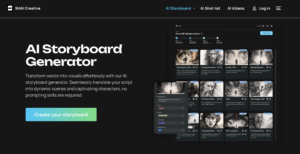
Shai’s intuitive interface where users can upload a script and generate visual storyboards, complete with scene sequencing, shot duration, and voiceover options — all in one platform.
Website: shaicreative.ai
Shai is the best alternative to Midjourney in 2025 if you’re working with scripts, visual storytelling, or film pre-production. Unlike Midjourney, Shai is designed specifically as an AI Storyboard Generator that turns scripts into shot-by-shot visual sequences — with voiceover, background music, transitions, and camera movement baked in.
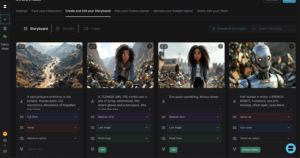
Shai storyboard view showing AI-generated frames from uploaded script
Features:
- Upload scripts or short ideas to instantly generate full storyboards
- Define tone, visual style, camera movements, and shot duration
- Includes sound and music syncing in generated videos
- Export to PDF, video, or presentation formats
- Offers versioning and team collaboration tools
- Templates tailored to ads, music videos, short films, social videos
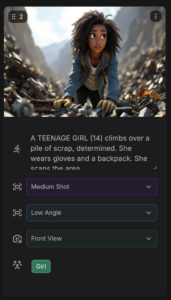
A single storyboard shot generated by Shai, showing visual, text, and camera details
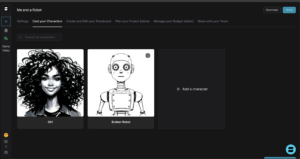
Customize characters to maintain visual consistency across shots
Shai vs Midjourney
- Storyboard creation: Shai builds structured shot sequences, Midjourney does not
- Script input: Shai accepts full script uploads, Midjourney doesn’t
- Continuity: Shai ensures visual consistency, Midjourney lacks this
- Output: Shai delivers animated sequences with sound, Midjourney only static images
- Use Case: Shai is filmmaker-first, Midjourney is artist-first
Cons:
- Not ideal for single concept art prompts
- Requires some onboarding to learn script formatting inputs
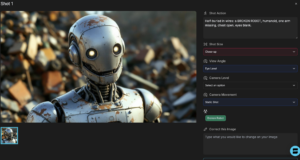
Edit AI-generated visuals directly in Shai with prompt tuning and framing controls
Shai is trusted by creative teams around the world for storyboard-driven production
From filmmakers to global brands, Shai is used by thousands of creatives to transform scripts into ready-to-use visuals for a wide range of formats:
🎬 Film & TV Production:
Directors, screenwriters, and producers use Shai to pre-visualize entire scenes from uploaded scripts — including shot duration, camera movement, and character continuity.
📢 Advertising Agencies:
Creative teams generate pitch-ready visuals and storyboards for ad campaigns, helping clients visualize concepts before any shoot begins.
🏢 Corporate Video Teams:
In-house media teams use Shai to storyboard training videos, internal messaging, and product explainers — without needing a designer on staff.
🎨 Animation Studios:
Animators use Shai to block scenes, maintain visual consistency between characters, and speed up the pre-production process.
📱 Social Media Content Creators:
Brands and influencers turn content briefs into vertical storyboards and short-form video concepts with transitions and style controls.
🎓 Education & Nonprofits:
Organizations use Shai to illustrate learning content, advocacy campaigns, and explainer visuals — even with limited production budgets.
🎥 Music Video Production:
Shai helps music video directors visualize mood, style, and narrative beats — complete with camera angles and visual rhythm.
🚀 Startups & Product Launches:
Founders use Shai to create visual concepts for launch campaigns, crowdfunding videos, and product walkthroughs — quickly and affordably.
Create an account to get started with Shai, for free
Story-Boards.ai
An entry-level AI storyboard generator that transforms script sections into image panels.
Features:
- Upload a script or description to generate storyboards
- Easy drag-and-drop panel sequencing
Story-Boards.ai vs Midjourney
- Offers storyboard structure, Midjourney doesn’t
- Focuses on filmmaking, Midjourney is more for general art
Cons:
- Visuals are basic and repetitive
- No support for motion, sound, or transitions
- No real editing tools
Storyboarder.ai
Helps users visually sketch storyboards using AI suggestions and text inputs.
Features:
- AI-powered visual sketching from scenes
- Minimal UI for fast iterations
- Compatible with some export formats
Storyboarder.ai vs Midjourney
- Offers panel organization, Midjourney doesn’t
- Accepts narrative inputs instead of prompts only
Cons:
- Limited visual fidelity
- Doesn’t support sound or video
- Struggles with complex shot instructions
StoryboardHero.ai
Tailored for marketers and agencies needing fast storyboard creation for ads and campaigns.
Features:
- Branded template creation
- Image and text overlay tools
- Client feedback loop with approval tracking
StoryboardHero.ai vs Midjourney
- Focus on presentation-ready decks, Midjourney is artistic
- Structure and flow from script, not just image generation
Cons:
- Lacks creative flexibility
- No animation or shot-level metadata
LTX Studio
An ambitious pre-vis platform focusing on video generation and AI narrative tools.
Features:
- Concept ideation using natural language
- Character and scene casting with AI
- Visual generation tied to basic storyline inputs
LTX Studio vs Midjourney
- Offers limited narrative-to-video flow, Midjourney has none
- Includes character generation, though not consistent yet
Cons:
- Still in beta, outputs vary widely
- No real shot-by-shot control yet
Krock.io
More of a creative workflow and client approval platform than a generator, but offers light storyboard support.
Features:
- Collaborative review and annotation
- Project timelines and asset management
Krock.io vs Midjourney
- Offers workflow tools, Midjourney is generation-only
- Great for feedback loops, not image creation
Cons:
- No built-in AI generation
- Not intended for story creation
Katalist.ai
A visual generation platform for content marketers and ad creators
Features:
- Product mockup generation
- Scene-based visual composition
Katalist.ai vs Midjourney
- Faster for ecommerce visual assets
- Offers some templating and batch generation
Cons:
- Lacks focus on narrative
- Not suitable for films or scripted stories
StoryTribe
Collaborative tool for building stories visually with team input
Features:
- Concept boards
- Note-based storytelling templates
StoryTribe vs Midjourney
- Built around story collaboration, not individual prompting
- Includes scene-building modules
Cons:
- No AI image generation
- Only useful in early concepting
OpenAI Sora
An advanced but currently closed AI video generation engine
Features:
- Realistic video generation
- High detail and dynamic motion
OpenAI Sora vs Midjourney
- Video-first vs. image-first
- Advanced realism vs. artistic abstraction
Cons:
- Not accessible to the public
- No user control over storyboarding
- No script-to-video pipeline
Final Thoughts
If you’re looking for a storytelling-driven, script-compatible, AI storyboard generator — Shai stands out far above the rest. Midjourney is still excellent for single image prompts, but for creators who think in scenes, sequences, and stories, it falls short.
Start your first storyboard with Shai for free at shaicreative.ai.